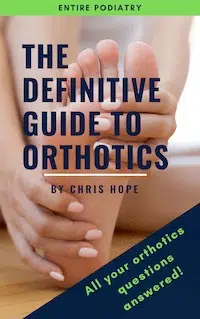If you’re currently experiencing knee pain from running or have sore knees after running, you’re not alone. This is one of the most common injuries affecting both recreational and elite runners. A systematic review found that injuries to the lower limb account for between 19.4% and 79.3% of all running-related injuries, with the knee being the most frequently affected joint (Van Gent et al., 2007).
Knee pain while running can be difficult to diagnose and manage, but it’s important to address, as it can significantly impact quality of life and alter your running biomechanics. Symptoms may include pain, stiffness, muscle inhibition, swelling, and even atrophy (Tesarz et al., 2020).
Common causes of knee pain from running include overuse, poor footwear, biomechanical inefficiencies, muscle imbalances, and degenerative conditions like arthritis.
The different areas of knee pain while running
Front of knee
As a high-impact sport, running can commonly induce pain at the front of the knee or closely surrounding the knee cap. The most common running-related knee injury is known as the runner’s knee, patellofemoral syndrome or bone bruising. Runner’s knee occurs as an overuse injury and is exacerbated by repetitive impact and poor tracking of the kneecap. Symptoms include pain, throbbing, stiffness or swelling. This pain could occur when bending the knee while completing movements such as squatting, sitting and walking upstairs or downstairs. During these movements, there may be crepitus and grinding present at the kneecap.
Outer knee pain
Outer or lateral knee pain during running can be due to tightness of the iliotibial band (ITB). This is a connective tissue connecting the hip to the knee and overuse while running can cause a sudden sharp pain, irritation and sometimes swelling at the outside of the knee. Other symptoms include clicking or popping sensations. Pain usually presents itself post run but still can occur during a run, if you increase your pace or when running downhill. ITB tightness, also known as ITB syndrome can result from a muscle imbalance. A weakness in the muscles at the hip or gluteal muscles have been known to cause excessive hip outward rotation and increase the internal rotation of the knee which adds more pressure and tightness through the ITB.
Back of the knee
Pain at the back of the knee could be due to a calf strain. The calves are the powerhouse for running, they consist of two main muscles: the gastrocnemius and soleus. These both combine to a tendon which attaches at the back of the heel, called the Achilles tendon. Any form of fatigue or weakness can result in pain in the back of the knee or if there is a sudden increase in intensity or volume when running. The popliteus muscle can also be affected while running as it significantly contributes to knee stability, controlling knee rotation and extension, making it most vulnerable on uneven surfaces or when running downhill. The popliteus muscle can also experience popliteal cysts which are fluid filled pockets of tissue. Although, there is no direct link showing that this cyst is formed through running, it can occur to runners due to the repetitive stress of the activity and is often an underlying symptom of meniscus damage or arthritis.
Below knee while running
Sudden pain below the knee while running could be due to Jumper’s knee where pain occurs below the kneecap while running. This overuse injury is accompanied with inflammation or in some cases even tearing of the patella tendon. The patella tendon attaches the front thigh muscle quadriceps to the patella bone which is also known as the knee cap. Pain may be noticed while stretching, sitting to standing and at the beginning of a run. In addition, landing from a jump and kneeling can aggravate further pain. Another common tendon that can be affected in the same area is the quadriceps tendon. The patella tendon connects the patella bone to the tibia, while the quadriceps tendon connects the quadriceps muscle to the patella bone. Therefore, pain at the patella tendon is usually above the kneecap (patella), while pain from a quadriceps tendon would be below the kneecap.
Knee cap hurts while running
As mentioned above runners’ knee can also cause pain or stiffness at the knee cap. Other injuries which can cause sharp pain deep into the knee include meniscus injuries. Knee meniscus refers to the cartilage which cushions the bones at the knee. Sudden twisting, pivoting or squatting movements can cause injuries to the meniscus while running. Another condition involving the back of knee cap is chondromalacia patella. This refers to the breakdown of cartilage at the patella, the cartilage allows the patella to glide over the femur bone. When chondromalacia patella occurs it can cause grinding, swelling and pain at the knee. Furthermore, another condition which affects the patella is a tracking disorder, wherein the patella does not glide in the correct area, which thereby results in clicking, pain and instability of the knee.
Other knee injuries/pain
Types of Pain / Symptoms
At the knee, the type of pain can sometimes indicate the severity of injury. A sharp pain may indicate a torn meniscus, ligament (ACL, MCL) or fracture. While a dull pain may indicate patellofemoral Pain Syndrome, osteoarthritis and tendonitis. Furthermore, there is a difference between inflammatory pain and instability at the knee. Inflammation involves symptoms such as pain, warmth and swelling, while instability refers to weakening of structures surrounding the knee. This weakness can also result in inflammation similar to the symptoms stated above.
ACL injury/tear
A more acute type of knee injury includes damage or even a tear to the anterior cruciate ligament (ACL). This can occur due to trauma, a specific fall or sudden pivot. The ACL is one of the main stabilising ligaments of the knee and it connects the femur to the tibia. An ACL injury can feel like a sharp pain which is sudden, however a mild sprain can feel like a throbbing dull pain with occasionally swelling but can be alleviated with rest.
Running after knee surgery
Depending on the surgery type, beginning to run again can be a difficult and long process. It requires consistent rehabilitation of lower limb strengthening and conditioning to return to previous running conditions. Without fully regaining strength, it can lead to further injury to the knee when running. Usually the injured knee is compared to the non-affected knee and it has to have at least 90% of the strength of the non-affected leg to be cleared for running. However, there are specific programs which include walking/jogging, power/plyometric strength and pivotal movements of the knee that are required to be completed before beginning to run.
Running after patellar dislocation or fracture
While uncommon, a patella dislocation can occur during a run, especially you are prone to dislocations at the knee or have had a previous dislocation or there is pre-ligamentous laxity surrounding the patella. A patella dislocation is when the knee bone moves out of the knee joint. Symptoms include acute and rapid swelling, extreme pain and discolouration of the medial side of the knee. Another injury to the patella is a patella fracture, this can be associated with running if there is a sudden contraction which causes the quadricep muscle and patella tendon to pull the kneecap or if there is direct impact to the knee, for example a direct fall on the concrete.
Adductor tendinopathy
Repetitive movements and constant change of directions at the lower limb can cause adductor tendinopathy. The adductor tendon controls flexion and rotation of the thigh and overuse can cause it to become inflamed. Pain can be gradual on onset and can radiate down the leg, usually there is pain or a burning sensation that occurs. Other risk factors include over stretching, muscle imbalance, leg length differences and sudden change in intensity.
Knee pain at events or on surfaces
Knee pain following any events including a 10K run, half marathon or even full marathon, can most commonly be due to runner’s knee or patellofemoral syndrome, as mentioned above. The majority of these events are held on concrete surfaces which is the hardest surface and this can impact bones, joints and tendons – further increasing risk of injury. Similarly, even running on a treadmill can result in knee pain; as even though it is softer, it can still strain knees due to repetitive and fixed stride length. Furthermore, running posture and type of running footwear can contribute to knee pain.
Another factor that affects knees is running downhill, as braking while running applies an exaggerated stress on the knees and specifically affects the quadriceps which control acceleration. Finally, it is possible to experience knee pain after not running for a while, as your knee strength may have degraded due to taking a break. Resuming with improper training or warm-up can shock the joints of the leg. The surrounding muscles, ligaments and tendons must be strengthened and intensity of training should be increased at a gradual rate when first beginning to run.
What might help?
Acute knee injuries – may need rest, icing and elevation
If not healing, may need assistance from a health professional, depending on the severity.
More chronic knee injuries – may require regular stretching and strengthening, footwear and orthotic recommendations or improvement of running form
Stretches for the knee include:
Basic stretches:
- Hip rotator stretch
- Quadriceps stretch
- Hamstring stretch
- IT Band stretch –
- Calf stretch (gastrocnemius)
- Calf stretch (soleus)
Knee workout for overall strengthening and recovery:
- Squats: Bodyweight or with weights
- Lunges: Bodyweight or with weights
- Hamstring curls or single-leg deadlifts (with weight)
- Clam shells
- Calf raises
Note: If you are new to knee exercises – start with low reps, sets and weights. Ensure proper form.
Need help? Every runner’s knee pain is different. For a personalised assessment and treatment plan, book a consultation with our experienced podiatrists.
References:
Van Gent, R.N., Siem, D., van Middelkoop, M., van Os, A.G., Bierma-Zeinstra, S.M.A., & Koes, B.W. (2007). Incidence and determinants of lower extremity running injuries in long distance runners: a systematic review. British Journal of Sports Medicine, 41(8), 469–480.
Tesarz, J., Gerhardt, A., Leisner, S., Janke, S., Seidler, G.H., & Eich, W. (2020). A novel experimental knee-pain model affects perceived pain and movement biomechanics. Scandinavian Journal of Pain, 20(1), 45–52.





